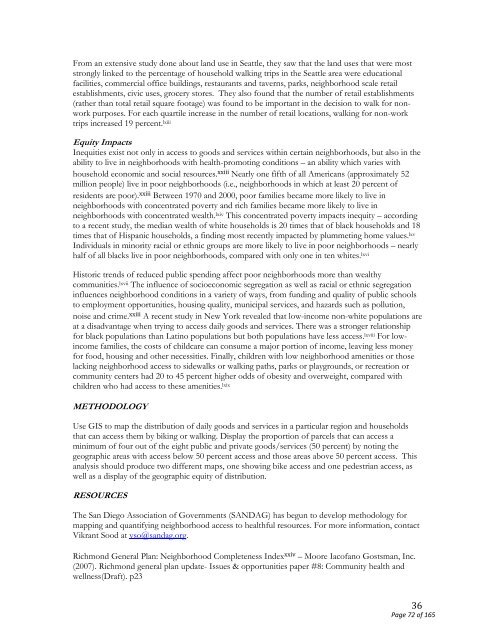Draft MTP/SCS Comments Received - sacog
Draft MTP/SCS Comments Received - sacog
Draft MTP/SCS Comments Received - sacog
Create successful ePaper yourself
Turn your PDF publications into a flip-book with our unique Google optimized e-Paper software.
From an extensive study done about land use in Seattle, they saw that the land uses that were most<br />
strongly linked to the percentage of household walking trips in the Seattle area were educational<br />
facilities, commercial office buildings, restaurants and taverns, parks, neighborhood scale retail<br />
establishments, civic uses, grocery stores. They also found that the number of retail establishments<br />
(rather than total retail square footage) was found to be important in the decision to walk for nonwork<br />
purposes. For each quartile increase in the number of retail locations, walking for non-work<br />
trips increased 19 percent. lxiii<br />
Equity Impacts<br />
Inequities exist not only in access to goods and services within certain neighborhoods, but also in the<br />
ability to live in neighborhoods with health-promoting conditions – an ability which varies with<br />
household economic and social resources. xxiii Nearly one fifth of all Americans (approximately 52<br />
million people) live in poor neighborhoods (i.e., neighborhoods in which at least 20 percent of<br />
residents are poor). xxiii Between 1970 and 2000, poor families became more likely to live in<br />
neighborhoods with concentrated poverty and rich families became more likely to live in<br />
neighborhoods with concentrated wealth. lxiv This concentrated poverty impacts inequity – according<br />
to a recent study, the median wealth of white households is 20 times that of black households and 18<br />
times that of Hispanic households, a finding most recently impacted by plummeting home values. lxv<br />
Individuals in minority racial or ethnic groups are more likely to live in poor neighborhoods – nearly<br />
half of all blacks live in poor neighborhoods, compared with only one in ten whites. lxvi<br />
Historic trends of reduced public spending affect poor neighborhoods more than wealthy<br />
communities. lxvii The influence of socioeconomic segregation as well as racial or ethnic segregation<br />
influences neighborhood conditions in a variety of ways, from funding and quality of public schools<br />
to employment opportunities, housing quality, municipal services, and hazards such as pollution,<br />
noise and crime. xxiii A recent study in New York revealed that low-income non-white populations are<br />
at a disadvantage when trying to access daily goods and services. There was a stronger relationship<br />
for black populations than Latino populations but both populations have less access. lxviii For lowincome<br />
families, the costs of childcare can consume a major portion of income, leaving less money<br />
for food, housing and other necessities. Finally, children with low neighborhood amenities or those<br />
lacking neighborhood access to sidewalks or walking paths, parks or playgrounds, or recreation or<br />
community centers had 20 to 45 percent higher odds of obesity and overweight, compared with<br />
children who had access to these amenities. lxix<br />
METHODOLOGY<br />
Use GIS to map the distribution of daily goods and services in a particular region and households<br />
that can access them by biking or walking. Display the proportion of parcels that can access a<br />
minimum of four out of the eight public and private goods/services (50 percent) by noting the<br />
geographic areas with access below 50 percent access and those areas above 50 percent access. This<br />
analysis should produce two different maps, one showing bike access and one pedestrian access, as<br />
well as a display of the geographic equity of distribution.<br />
RESOURCES<br />
The San Diego Association of Governments (SANDAG) has begun to develop methodology for<br />
mapping and quantifying neighborhood access to healthful resources. For more information, contact<br />
Vikrant Sood at vso@sandag.org.<br />
Richmond General Plan: Neighborhood Completeness Index xxiv – Moore Iacofano Gostsman, Inc.<br />
(2007). Richmond general plan update- Issues & opportunities paper #8: Community health and<br />
wellness(<strong>Draft</strong>). p23<br />
36<br />
Page 72 of 165
















